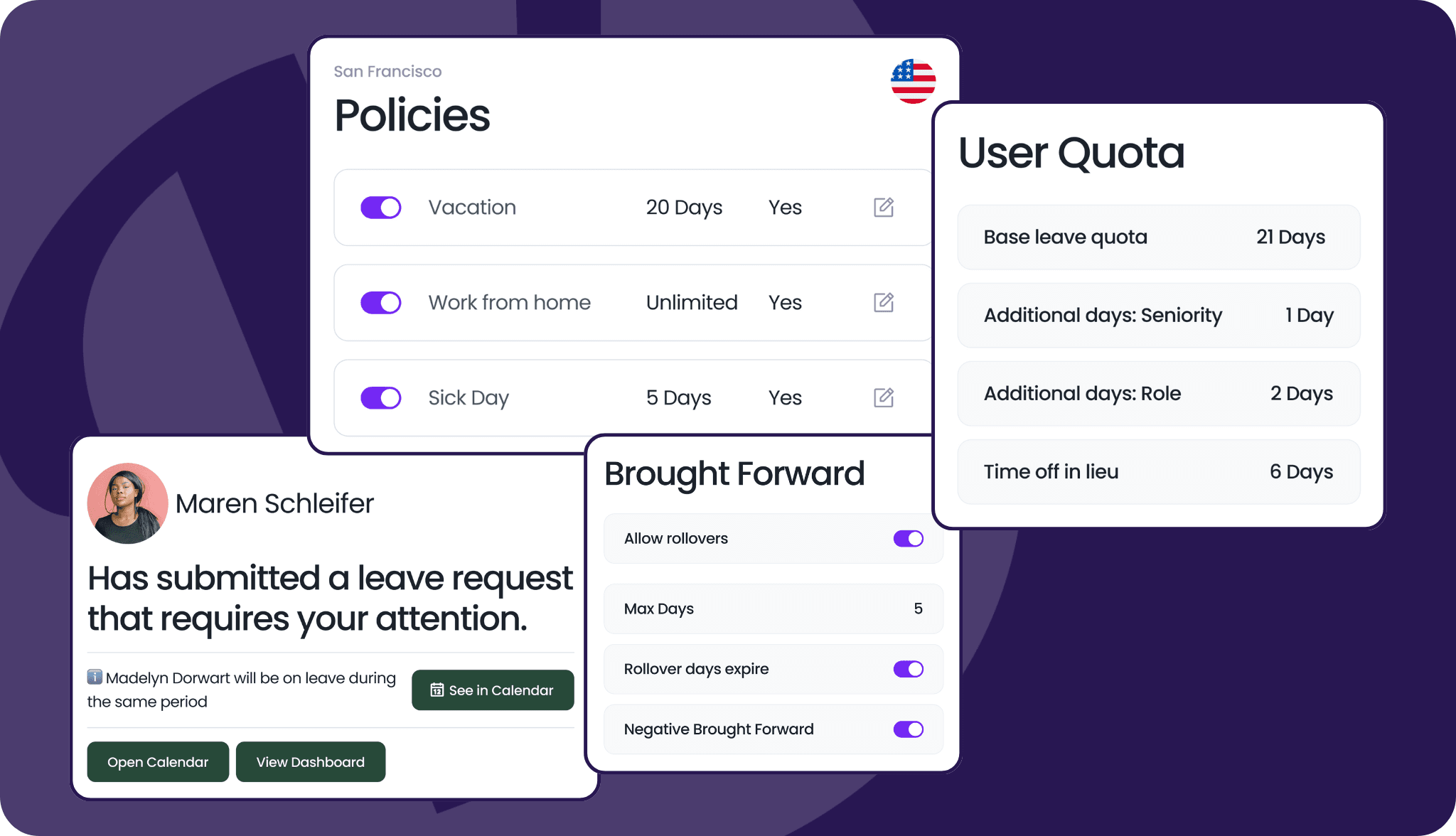Last updated on November 14, 2025
Annual leave entitlement is a fancy way to refer to your team’s yearly amount of vacation days. Each company has its own rules on how much time off their employees get, depending on internal culture and local leave laws. Some offer none (which would make the math in this case quite easy), others offer the standard two to four weeks, and some companies offer unlimited PTO.
If your company offers a set number of days off each year, you must calculate it correctly, so your policies feel fair and are compliant and your employees get the rest they deserve.
In this guide, we’ll teach you everything you need to know about annual leave entitlement, the factors that affect it, how to calculate it, common challenges HR teams face, and how to make tracking leave easier. Let’s get started.
What Is Annual Leave Entitlement?
Annual leave entitlement is the number of paid days off work an employee is entitled to over a year. In other words, it’s an employee’s yearly allowance of vacation days, also known as paid annual leave or PTO.
Most countries legally require employers to provide a minimum amount of annual leave to full-time employees. For example, many European countries mandate at least four weeks of paid vacation per year, while the United States has no federal law guaranteeing paid vacation time.
Companies can choose to offer more generous leave as part of their benefits package. The exact entitlement for each employee will differ depending on your region, company policy, and local labor laws.
Factors That Affect Leave Entitlement
Employment Status
Full-time employees typically receive the standard annual leave allowance set by law or company policy. PTO for part-time employees is usually pro-rated based on the hours or days they work compared to full-timers.
For example, if full-time employees working 40 hours per week get 20 days of leave, a part-time employee working 20 hours per week would be entitled to about 10 days. Since they work half the hours, they also earn half the leave.
Start Dates and Probationary Periods
When an employee joins partway through the year, their leave entitlement is usually pro-rated to the portion of the year worked. For example, if someone starts on July 1st, halfway through the calendar year, they would be entitled to roughly 50% of the full annual leave that year.
Some companies also have probationary periods, usually a 3-month period, during which new hires cannot take leave. Most company policies still allow them to accrue leave during this time, so this usually doesn’t change their total entitlement but rather impacts when they can start using it.
Brought Forward Rules
Brought forward, also called PTO rollovers, refers to whether unused leave at the end of a year can be carried into the next year. Some companies allow a limited number of unused days to carry over or set an expiration date for when these brought forward days can be used.
For example, a company policy may allow employees to roll over up to 5 days which need to be used within 6 months. This prevents employees from accruing an unreasonable amount of PTO.
As an alternative, some organizations enforce a “use-it-or-lose-it” rule, where all unused days expire at the end of the year.
Brought-forward policies will affect an employee’s leave balance in the new year and should be factored into their available leave.
Local Labor Laws
Local labor laws define the minimum annual leave entitlement in many regions, and these can depend on factors like an employee’s tenure or contract type.
The European Union’s Working Time Directive sets a minimum of 4 weeks of paid leave, whereas the U.S. has no mandated minimum, leaving PTO up to the employer. Certain countries, like Canada, increase leave entitlements based on years of service.
HR must be aware of the laws in each country or state your business operates in to ensure your company’s leave policy meets at least those minimums. Many employers offer more than the legal minimum to stay competitive and keep employees happy, but you can never go below the legal minimum.
Accrual Methods
Leave entitlement is also affected by accrual rates. Some organizations give the full year’s leave upfront, meaning all their PTO days would be added to their balance on the first day of the year.
Another method would be to allow employees to earn leave gradually, better known as PTO accruals. This means that rather than receiving a lump sum, time off is calculated as a ratio of time worked. This can be calculated based on hours, days, weeks, or months, depending on the company’s preferences and structure.
Accruals make sure that an employee’s earned leave is proportional to how much they’ve worked so that if someone leaves mid-year, they’ve only taken the leave they earned. If leave is offered as a lump sum, it’s possible that an employee uses up their entire year’s leave quota but quits midway through the year, resulting in a loss for the company.
How to Calculate Annual Leave Entitlements (with Examples)
![]()
Calculating Annual Leave for Full-Time Employees
This one is really easy!
For a full-time employee who works the entire leave year, there is no real need to calculate. All you need to know is the annual entitlement defined by your company, employment contract, or law.
For example, if your company policy gives 15 days of vacation per year to full-time staff, a full-time employee who works the whole year is entitled to 15 days. If you measure time off in hours, that would be 120 hours.
Remember, if your company allows unused leave to be carried over, you'll need to add that to the base quota. Plus, if your company uses accruals, you'll need to make sure the PTO is added to their bank at the correct time, in the correct increments.
Calculating Pro-Rated Leave Entitlements
Now is where you may want to get your calculator out!
For part-time employees and those who didn’t work a full year, you’ll calculate their leave on a proportional basis to ensure fairness. The idea is to give a portion of the full-time annual entitlement corresponding to the fraction of time the person worked.
Part-Time Employees
Annual leave is awarded to part-timers in proportion to their working hours.
Here's how we calculate that:
(Employee’s weekly hours ÷ Full-time weekly hours) × Full-time annual leave entitlement = Pro-rated annual leave
Don’t get scared, we’ll do an example together.
Let’s say full-time employees at your company work 40 hours per week and are entitled to 20 days of leave.
Now, let’s find out what a part-time employee working 20 hours per week would get.
Let’s start by dividing the employee’s weekly hours by the standard full-time weekly hours:
20 hours per week ÷ 40 full-time weekly hours = 0.5
Now, we multiply that number by the annual leave entitlement, which in this case is 20:
0.5 × 20 days of annual leave = 10 days of annual leave per year.
To find out your part-time employee's annual leave entitlement, you just need to plug in your numbers in the formula and you’ll be done in no time.
New Hires or Seasonal Employees
If an employee started midway through the year or only works a portion of the year, you’ll calculate their entitlement based on the portion of the year they did work.
A common method is dividing by months:
(Number of months employed ÷ 12) × full annual entitlement = Pro-rated annual leave
Let's try another scenario.
How much leave would an employee who joined halfway through the year get if the full-time entitlement is 24 days?
First, we would divide 6 months of employment by 12 months in a year:
6 ÷ 12 = 0.5
Then we would multiply 0.5 by the annual full-time leave entitlement to know the pro-rated annual leave entitlement:
0.5 x 24 = 12
In this case, the employee would be entitled to 12 days off. Does that make sense? We sure hope so.
Common Challenges HR Teams Face
Even when you know how to calculate leave entitlements, managing them in practice can present challenges. Here are some common issues HR professionals and managers encounter:
- Changing policies: Company policies are never static and that applies to PTO as well. Your organization might increase or decrease the number of vacation days or change rollover rules. Whenever policies change, HR needs to recalculate entitlements, risking inconsistencies or confusion if records aren’t updated properly.
- Manual errors: Many small businesses start out tracking annual leave in spreadsheets or on paper. Unfortunately, manual tracking is prone to human error. A formula mistake or typo can quickly lead to incorrect balances, causing frustration and compliance issues.
- Managing global teams: If your business operates in multiple countries or regions, you must manage different leave laws and public holidays. Ensuring compliance with each area’s requirements and keeping policies up to date as laws change can be very challenging and prone to oversights or errors.
- Lack of visibility: Both employees and managers need clear visibility into leave balances and upcoming time off. Without a centralized system, employees may not know their remaining days and managers can accidentally approve overlapping vacations.
But fear not! While all these challenges are very real and can feel overwhelming, keep reading to discover how to make tracking annual leave entitlements easier and more accurate.
How To Track Annual Leave
Accurately tracking annual leave entitlement for each employee is crucial and, as we’ve explored together, can get complicated when factoring in accruals, carry-overs, different laws, and policy changes.
The good news is you don’t have to manage all of this on spreadsheets. Dedicated leave management systems can simplify the entire process and help you avoid the need for time-consuming formulas and manual work.
Yes, that means no need for calculators and tracking down email chains or digging through your desk for old, faded paper forms. Vacation Tracker automates the entire process for you.

All an admin needs to do is input your company’s policy details, customized for each location, into our system. The entire setup takes under 30 minutes and then it’s hands off from there. Vacation Tracker will manage yearly leave quotas, accrual rates, carry-over rules, and personalized entitlements based on roles or seniority.
And that's all you need to do to keep track of each employee's leave entitlement. Vacation Tracker calculates each employee’s quota accordingly, automatically pro-rating when necessary.
Employees can check their remaining leave balance and submit time-off requests in just a few clicks, from our dashboard or from within our Slack and Microsoft Teams integrations. Managers are notified instantly and can approve or deny the request, after which the system updates the employee’s leave balance and the team leave calendar automatically. This self-service approach eliminates back-and-forth emails and ensures everyone knows who will be off and when.
Ready to say goodbye to mental math, spreadsheets, and guesswork?
Managing annual leave entitlement doesn’t have to be complicated. With Vacation Tracker, calculations and compliance manage themselves for you, so you can focus on more meaningful work.
Start using Vacation Tracker for free today and enjoy the peace of mind that comes with accurate, up-to-date annual leave calculations.

Claudia
Claudia is an experienced marketer with a passion for writing and creating engaging content that connects with readers.




